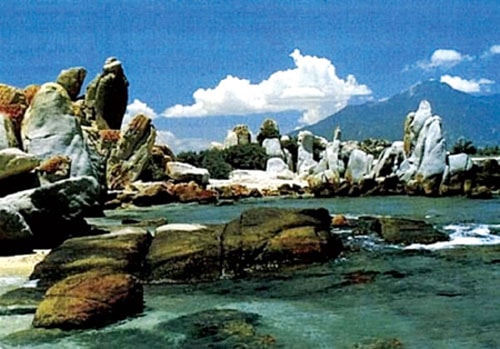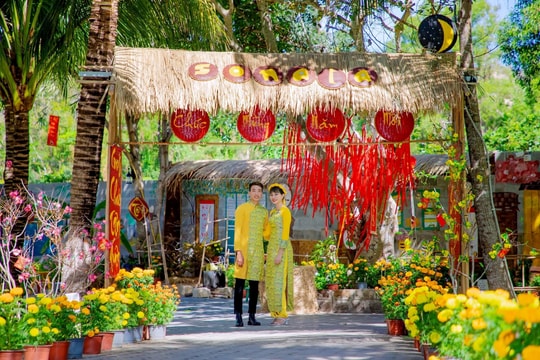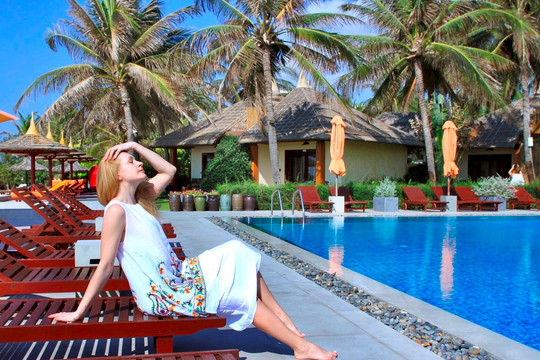 |
Tuy Phong is Binh Thuan province’s border area belonging to a severe climatic region with year-round sun and wind. Yet, several wonderful natural sceneries containing legends of the nomads during the period of reclaiming the land and setting the village had been made up for this land by the Creator. The small Cu Lau Cau Island among the vast sea looks like a wonder agglomerated a great number of unique values and poetic space.
From Phuoc The seashore, it takes us about 40 minutes by boat to approach Cu Lao Cau Island which was formed by a 1.5 kilometer-long steep range of rocks. From a far distance, the island looks like the back of a naiad in the legend with rolling mass of adhesive stones, creating an ancient citadel and rampart to confront against the storms blowing suddenly from the East Sea.
There has not been any population that is full of shapes and colors and brings a lot of emotion to visitors like here. For instance, the imposing statues of goddess and vong phu (a wife waiting for her husband) have also aroused visitors’ emotion. Specifically, visitors can contemplate the images of a flock of seagulls coming to the surface to take the air, or seals, dolphins, chamois looking around to find their fellows from every position. In fact, these are eternally quiescent masses of stones on this island. We can not find out any big tree’s shadows on the island, but there are a lot of alternate green bush covers and wild grass covers in every corner and space of the rocks.
Besides the above mentioned images, the purple flowers of sea water morning glory on the smooth sand-bank covering the gleaming shell pull back visitors’ steps. The natural arrangement of the wonderful destinations of Tam Tien beach, Coral beach, Ca Suot (Atheriniformes) ground, Cay beach, Mieu beach and so forth on the island looks like a mild sandy path under the large assembled rocks that can shelter visitors from sun and rain. Otherwise, the paths leading to Love cave and Ba Hon cave do not bear the sensational and mysterious features as others, but we can perceive the fanciful paintings created by the beauty of moss on the cliff.
There are not any sources of fresh water on Cu Lau Cau Island because the highest position over the sea surface is no more than 7 meters with layer upon number of rocks overlapped in a hustle. Yet the fairy well is just a deep concave on a large rock, but it can accumulate a huge course of fresh and clear water all year round. Legend has it that this well became a “royal well” of Gia Long dynasty on the way to refuge from Tay Son troop’s pursuit. As the nights fell, the snakes rendered assistance to the King coming here to stand guard at the water source in the well to keep it fresh and pure.
The most favorable weather to travel to Cu Lao Cau Island is after Lunar New Year when the South wind starts to stop blowing, so the wave and sea are calm. Nights on the island are very romantic because of the resonance of waves and the bright moonlight of March. If looking towards the mainland in the dim light from Ca Na, Lien Huong, Binh Thanh, La Gan … the small island looks like the first wharf of the ancient settlers.
Thien Y Ana Holy mother temple and Nam Hai (Whale-worshipping) temple of the fishermen existed from long time ago. As usual, ritual day is on every full moon day in April (lunar calendar). It is easy to find each flock of fishes swimming around the colorful corals under the clear bottom of the sea by the cliff. Visitors can enjoy swimming fantastically in the sea under the high and large sky.
Cu Lau Cau destination is also called Hon Cau which sounds like a pastoral time. Since the fishermen don’t have big boat to be offshore, they moor their boats at the island to fish for daily meals. With the stable tropical marine biodiversity, this island becomes a place of birth and growth of plentiful aquatic species. Cu Lau Cau Island is not only a meaningful place for local fishermen in the ways of earning their living as the name mentioned in the natural potential conservation planning, but it also opens a new types of marine eco-tourism for the locality.
My Thien (Source: Binh Thuan Newspaper)

















.jpg)





.jpeg)

.jpeg)


.jpeg)


